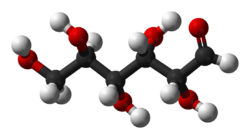Which Of The Following Hormones Increases Blood Glucose Levels

Ball-and-stick model of a glucose molecule
Blood sugar regulation is the process past which the levels of blood sugar, primarily glucose, are maintained past the body within a narrow range. This tight regulation is referred to as glucose homeostasis. Insulin, which lowers blood sugar, and glucagon, which raises it, are the most well known of the hormones involved, but more recent discoveries of other glucoregulatory hormones have expanded the understanding of this procedure. The gland called pancreas secrete ii hormones and they are primarily responsible to regulate glucose levels in blood.[1]
Mechanisms [edit]

The flat line is the optimal blood sugar level (i.east. the homeostatic fix point). Blood sugar levels are balanced past the tug-of-war betwixt 2 functionally contrary hormones, glucagon and insulin.
Blood sugar levels are regulated past negative feedback in order to keep the body in balance. The levels of glucose in the blood are monitored by many tissues, but the cells in the pancreatic islets are among the about well understood and important.
Granule docking is an of import glucose-dependent step in man insulin secretion that does not piece of work properly in blazon 2 diabetes.[2]
Glucagon [edit]
If the claret glucose level falls to dangerously low levels (every bit during very heavy practice or lack of food for extended periods), the alpha cells of the pancreas release glucagon, a hormone which travels through the blood to the liver, where it binds to glucagon receptors on the surface of liver cells and stimulates them to suspension downward glycogen stored inside the cells into glucose (this process is called glycogenolysis). The cells release the glucose into the bloodstream, increasing blood sugar levels. Hypoglycemia, the state of having low claret sugar, is treated by restoring the blood glucose level to normal past the ingestion or assistants of dextrose or saccharide foods. It is often self-diagnosed and self-medicated orally by the ingestion of balanced meals. In more than severe circumstances, it is treated by injection or infusion of glucagon.
Insulin [edit]
When levels of blood sugar ascent, whether as a result of glycogen conversion, or from digestion of a repast, a different hormone is released from beta cells found in the islets of Langerhans in the pancreas. This hormone, insulin, causes the liver to convert more glucose into glycogen (this process is called glycogenesis), and to force near 2/3 of trunk cells (primarily muscle and fat tissue cells) to accept up glucose from the claret through the GLUT4 transporter, thus decreasing blood sugar. When insulin binds to the receptors on the cell surface, vesicles containing the GLUT4 transporters come to the plasma membrane and fuse together by the process of endocytosis, thus enabling a facilitated improvidence of glucose into the prison cell. As soon every bit the glucose enters the cell, it is phosphorylated into glucose-6-phosphate in order to preserve the concentration gradient so glucose volition continue to enter the cell.[3] Insulin also provides signals to several other body systems, and is the chief regulator of metabolic control in humans.
There are also several other causes for an increase in blood sugar levels. Among them are the 'stress' hormones such as epinephrine (also known as adrenaline), several of the steroids, infections, trauma, and of form, the ingestion of food.
Diabetes mellitus blazon i is caused by insufficient or not-existent production of insulin, while type 2 is primarily due to a decreased response to insulin in the tissues of the body (insulin resistance). Both types of diabetes, if untreated, result in too much glucose remaining in the claret (hyperglycemia) and many of the same complications. Likewise, too much insulin and/or do without plenty corresponding nutrient intake in diabetics can result in depression blood sugar (hypoglycemia).
Hormones that influence claret glucose level [edit]
| Hormone | Tissue of origin | Metabolic effect | Issue on blood glucose |
|---|---|---|---|
| Insulin | Pancreatic β Cells | 1) Enhances entry of glucose into cells; two) Enhances storage of glucose every bit glycogen, or conversion to fatty acids; iii) Enhances synthesis of fatty acids and proteins; 4) Suppresses breakdown of proteins into amino acids, and Triglycerides (from adipose tissue) into gratis fatty acids. | Lowers |
| Amylin [ane] | Pancreatic β Cells | one) Suppresses glucagon secretion afterward eating; 2) Slows gastric emptying; 3) Reduces food intake. | Lowers |
| GLP-1 [1] | Intestinal L cells | 1) Enhances glucose-dependent insulin secretion; 2) Suppresses glucagon secretion afterwards eating; 3) Slows gastric emptying; 4) Reduces nutrient intake. (Only works while food is in the gut) | Lowers |
| GIP | Intestinal K cells | 1) Induce insulin secretion 2) Inhibits apoptosis of the pancreatic beta cells and promotes their proliferation 3) Stimulates glucagon secretion and fat aggregating | Lowers |
| Glucagon | Pancreatic α Cells | one) Enhances release of glucose from glycogen (glycogenolysis); 2) Enhances synthesis of glucose (gluconeogenesis) from amino acids or fats. | Raises |
| Asprosin [4] | White adipose tissue | 1) Enhances release of liver glucose during fasting. | Raises |
| Somatostatin | Pancreatic δ Cells | 1) Suppresses glucagon release from α cells (acts locally); two) Suppresses release of Insulin, Pituitary tropic hormones, gastrin and secretin. 3) Decreases stomach acid production by preventing the release of other hormones (gastrin and histamine), thus slowing downwards the digestive procedure. | Lowers[ citation needed ] |
| Epinephrine | Adrenal medulla | ane) Enhances release of glucose from glycogen; ii) Enhances release of fat acids from adipose tissue. | Raises |
| Cortisol | Adrenal cortex | 1) Enhances gluconeogenesis; 2) Antagonizes insulin. | Raises |
| ACTH | Anterior pituitary | i) Enhances release of cortisol; ii) Enhances release of fatty acids from adipose tissue. | Raises |
| Growth hormone | Inductive pituitary | Antagonizes insulin | Raises |
| Thyroxine | Thyroid | 1) Enhances release of glucose from glycogen; 2) Enhances absorption of sugars from intestine. | Raises |
References [edit]
- ^ a b c Aronoff SL, Berkowitz K, Shreiner B, Want L (2004). "Glucose metabolism and regulation: Beyond insulin and glucagon". Diabetes Spectrum. 17 (3): 183–90. doi:10.2337/diaspect.17.3.183. Archived from the original on 2022-12-17. Retrieved 2016-12-07 .
- ^ Gandasi, Nikhil R.; Yin, Peng; Omar-Hmeadi, Muhmmad; Laakso, Emilia Ottosson; Vikman, Petter; Barg, Sebastian (2018-02-06). "Glucose-Dependent Granule Docking Limits Insulin Secretion and Is Decreased in Homo Type 2 Diabetes". Cell Metabolism. 27 (two): 470–478.e4. doi:10.1016/j.cmet.2017.12.017. ISSN 1550-4131. PMID 29414688.
- ^ Ebey Soman, Scienceray, Regulation of Glucose past Insulin Archived July 16, 2022, at the Wayback Machine, May iv, 2009. Retrieved November 1, 2009.
- ^ Romere C, Duerrschmid C, Bournat J, Constable P, Jain Chiliad, Xia F, Saha PK, Del Solar Thousand, Zhu B, York B, Sarkar P, Rendon DA, Gaber MW, LeMaire SA, Coselli JS, Milewicz DM, Sutton VR, Butte NF, Moore DD, Chopra AR (April 2022). "Asprosin, a Fasting-Induced Glucogenic Protein Hormone". Cell. 165 (iii): 566–79. doi:x.1016/j.jail cell.2016.02.063. PMC4852710. PMID 27087445.
Which Of The Following Hormones Increases Blood Glucose Levels,
Source: https://en.wikipedia.org/wiki/Blood_sugar_regulation
Posted by: shawsmandertne.blogspot.com


0 Response to "Which Of The Following Hormones Increases Blood Glucose Levels"
Post a Comment